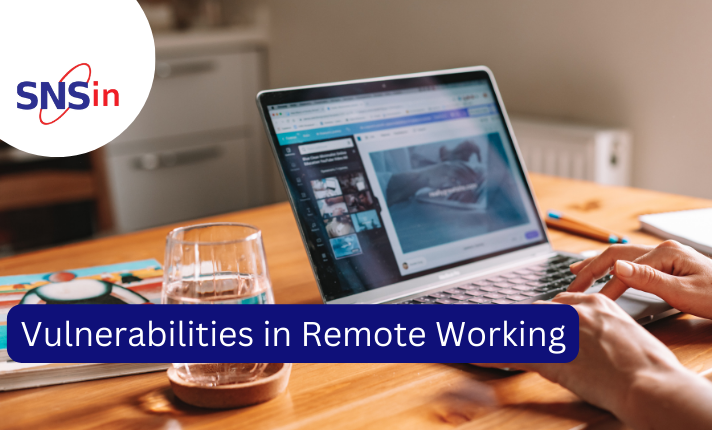Remote working has become a new normal for organizations globally, but it has contributed significantly to cyber security risks. The increased use of the public cloud to ease and facilitate remote working has also been a reason for this impact.
Remote Working and Cyber Security Risks
The potential for cyberattacks is much greater in a remote work setup. Data breaches and other cyberattacks are, therefore, easier to carry out. Furthermore, the lack of employee training and ignorance on the part of personnel further aggravates the issue. Cybercriminals are eyeing this shift to infiltrate networks through the use of sophisticated technology which easily bypasses the not-so-stringent risk aversion techniques.
Let us understand a few of these cyber risks in more detail.
-
Use of unverified Wi-Fi networks: When an employee tries to connect wireless devices to unsecured public Wi-Fi to access their organizational data and accounts, it creates an opening for hackers to disrupt the connection and capture sensitive data. For example, information exchanged without encryption might be intercepted and breached by malicious actors. Unless employees use a Secure VPN, they should not be allowed to connect to unverified internet networks, especially when accessing company data.
-
Weak password policy: Human error occurs when employees use weak passwords to secure their company portal logins, even if they use Secure VPNs, Next-Gen firewalls, and other measures to keep cyber security risks at bay. These mistakes are easier to exploit and bypass, which is why cybercriminals can crack passwords and gain access to sensitive data. Using old passwords, too, carries the same risk.
-
Poor data practices and procedures: Employees may sometimes knowingly or unknowingly download organizational data using unprotected network connections. It adds a layer of risk since the cyber attackers can use the opportunity to enter the network and extract the data needed to execute a cyberattack.
-
Working with personal devices: Employees download numerous files and apps on their personal devices; to achieve ease while working. Security can be compromised if one fails to exercise wisdom and uses the data for personal gain. Besides, if they leave their devices unattended & unprotected, it is possible that someone with malicious intent to hack the data without the employee’s knowledge.
-
Vulnerable hardware: The forced shift to remote working because of the pandemic meant that many employees use their devices to do the job, regardless of whether they could set up Wi-Fi at home or use laptops and smartphones properly equipped to handle data breaches and software vulnerabilities. These became modus operandi without much effort for cybercriminals.
-
Phishing or Ransomware attacks: Phishing continues to be a pervasive threat, irrespective of technological awareness by all user groups. The risk is greater when employees work remotely since there is an increased dependence on email. Employees are less suspicious of a phishing attack that is too well-engineered to be noticed and seems like a genuine business request.
Ransomware prohibits the user’s access to their device by locking the screen or encrypting their files till a ransom is paid. These cyberattacks put the whole organization at risk, and owners are forced to shell out a considerable lump sum to hackers to protect their data and vulnerabilities.
-
Webcam hacking: Employees use video calling and other online collaborative platforms to interact with their peers or hold meetings where confidential organizational information is shared without hesitation. Cybercriminals are always on the prowl for an opportunity to eavesdrop and use what they can to their advantage. Sophisticated socially engineered attacks are on the rise precisely because attackers employ a method that the employees have accepted as invincible.
Best Practices to Stay Clear of Remote Working Cyber Security Risks
Companies following best practices can drastically reduce the risk of cyberattacks.
Explanations for some of these are given below:
-
SWOT analysis and vulnerability management program: Using a technology-based data-driven approach can make an organization aware of the weaknesses which can become possible entry points for cyber attackers. An objective view of these, along with the adequate implementation of regulatory infrastructures, can reduce the impact to a vast degree.
-
Establishing a zero-trust framework: The maximum breach incidents occur when employees let their guards down and take security framework procedures for granted. Ask all users to verify their identity with multiple authentication checks to gain access to the networks and devices within the network.
-
Stronger data protection: Organizations should know what is at stake regarding sensitive data, the location of sensitive data and the impact if such data is compromised. This will ensure stringent control on formulating access guidelines and various other processes within the organization.
-
Cloud configurations and access to be reviewed: Misconfigurations are a major cause of unfavourable data breaches. Taking measures to eliminate glitches, errors and gaps are important in ensuring that the system is fool proof to the last mile.
Summary
Organizations have adopted a Hybrid working environment since the COVID-19 Pandemic. However, it is a must to be equipped with secure remote working protocols and follow Cyber Security standard procedures in protecting organizational data. User awareness training workshops also go a long way in minimising such risks.
Organizations must deploy effective Endpoint solutions, Next-Gen Firewall solutions, Secure VPN, Mobile Device Management solutions, Email Security & Phishing Simulation Software and User-Awareness Trainings to enhance the Cyber Security posture of the organization. This in turn, drastically reduces the inherent financial risks.
![]()




